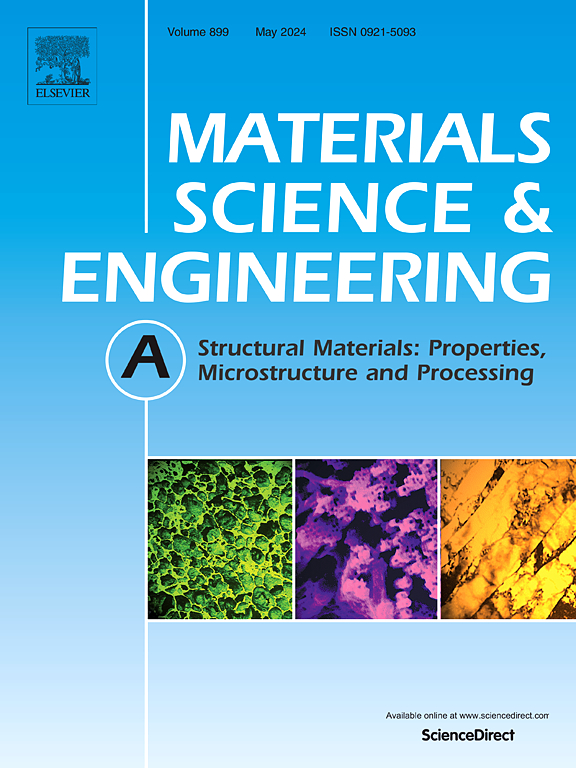Core-shell strategy for triple-phase reinforced (Al2O3+SiC+Al3BC)/Al composite: Achieving enhanced stiffness and strength while retained ductility
IF 7
2区 材料科学
Q1 MATERIALS SCIENCE, MULTIDISCIPLINARY
引用次数: 0
Abstract
Novel (Al2O3+SiC + Al3BC)/Al composites were successfully synthesized via in-situ reactions within the Al-B2O3-SiC system, aiming to significantly enhance strength and stiffness while maintaining favorable ductility. The resulting composites exhibit a hybrid microstructure comprising uniformly dispersed in-situ γ-Al2O3 nanoparticles and core-shell structured SiC@Al3BC particles, in which ex-situ SiC is coated by an in-situ formed Al3BC shell. Among the compositions studied, the Al-5B2O3-10SiC composite exhibited the most balanced combination of properties at room temperature, with a Young's modulus of 104 ± 1 GPa, an ultimate tensile strength (UTS) of 440 ± 4 MPa, and an elongation to failure (EL) of 4.1 ± 0.6 %. Notably, this composite also demonstrated significant thermal stability, retaining a UTS of 191 ± 6 MPa and an EL of 3.7 ± 0.3 % at 350 °C. The concurrent enhancement in stiffness and strength is attributed to synergistic reinforcement mechanisms, including the rule-of-mixtures contribution from high-modulus phases, nano-scale strengthening from Al2O3, and improved load transfer enabled by the SiC@Al3BC-Al interface. Further increases in SiC content to 20 wt% or the B2O3 content to 10 wt% led to additional improvements, achieving moduli of 114 ± 2 GPa and 118 ± 2 GPa, and UTS values of 548 ± 6 MPa and 538 ± 3 MPa, respectively. These results demonstrate the potential of the proposed composite design for advanced applications operating under both ambient and elevated temperature conditions.
三相增强(Al2O3+SiC+Al3BC)/Al复合材料的核壳策略:在保持延展性的同时获得更高的刚度和强度
在Al- b2o3 -SiC体系中,通过原位反应成功合成了新型的(Al2O3+SiC + Al3BC)/Al复合材料,其强度和刚度得到了显著提高,同时保持了良好的延展性。复合材料呈现出由均匀分散的原位γ-Al2O3纳米颗粒和核壳结构SiC@Al3BC颗粒组成的杂化微观结构,其中原位SiC被原位形成的Al3BC壳层包裹。在所研究的复合材料中,Al-5B2O3-10SiC复合材料在室温下表现出最平衡的性能组合,杨氏模量为104±1 GPa,极限抗拉强度(UTS)为440±4 MPa,断裂伸长率(EL)为4.1±0.6%。值得注意的是,该复合材料还表现出了显著的热稳定性,在350°C时保持了191±6 MPa的UTS和3.7±0.3%的EL。同时增强的刚度和强度归因于协同增强机制,包括高模量相的混合规则贡献,Al2O3的纳米级强化,以及SiC@Al3BC-Al界面改善的载荷传递。进一步将SiC含量增加到20 wt%或B2O3含量增加到10 wt%,可以进一步改善,模量分别为114±2 GPa和118±2 GPa, UTS值分别为548±6 MPa和538±3 MPa。这些结果证明了所提出的复合材料设计在环境和高温条件下的先进应用的潜力。
本文章由计算机程序翻译,如有差异,请以英文原文为准。
求助全文
约1分钟内获得全文
求助全文
来源期刊

Materials Science and Engineering: A
工程技术-材料科学:综合
CiteScore
11.50
自引率
15.60%
发文量
1811
审稿时长
31 days
期刊介绍:
Materials Science and Engineering A provides an international medium for the publication of theoretical and experimental studies related to the load-bearing capacity of materials as influenced by their basic properties, processing history, microstructure and operating environment. Appropriate submissions to Materials Science and Engineering A should include scientific and/or engineering factors which affect the microstructure - strength relationships of materials and report the changes to mechanical behavior.
 求助内容:
求助内容: 应助结果提醒方式:
应助结果提醒方式:


